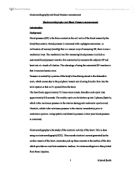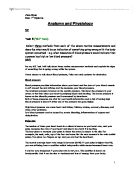The subjects arm was fully uncovered and the cuff was applied on the upper part of the arm, making sure the sleeve of the shirt of the subject was not restricting their blood flow. The arm was extended at the elbow with the forearm supported on the table. The muscles of the arm were fully relaxed to make sure blood flow was normal. Then the automated blood pressure monitors started, the cuff inflated to roughly 180mmHg to collapse the artery, which stopped the blood flow. The pressure then decreased slowly and the blood flow returned through the constricted vessel. After the pressure dropped the results of the subjects blood pressure and heart rate appeared on the monitors.
The results on the monitors show the subjects diastolic and systolic pressure along with their heart rate. From the diastolic and systolic blood pressure you are able to calculate the pulse and mean pressure, like so: -
Taking baseline pressure
The subject sat down for 5 minutes, not moving nor speaking. After the 5 minute period the blood pressure and heart rate readings were taken by the automated BP monitors. After the blood pressure and heart rate readings were taken the subject sat for a further 5 minutes and the readings were taken again.
Effect of posture on blood pressure, part 1
After the baseline measurements were taken and the subject was fully relaxed they stood up (still remaining relaxed). Their blood pressure and heart rate was taken immediately. This was compared to the baseline readings for sitting
Effect of posture on blood pressure, part 2
As an extra study on the effects of blood pressure the subject lay on the floor fully relaxed for 5 minutes, after the 5 minute period the subjects blood pressure and heart rate was taken. This was compared to the baseline readings for sitting and standing.
Effect of temperature stress on blood pressure
The subject put the hand which had the automated blood pressure monitor attached too in a bucket of ice, up to their wrist and left it their for 2 minutes i.e. left hand in ice, left arm being measured. After 2 minutes their blood pressure was taken from the arm which hand was in the ice, and this was repeated every 5 minutes until they returned to the baseline values. This was repeated, but the measurements were taken from the arm which hand was not in the ice i.e. the left in ice, right arm being measured.
Effect of exercise on blood pressure
The subject had to cycle on a cycle ergometer at a cadence of exactly 60 revs per minute. There were two different stages: -
Stage 1 and Stage 2
The subjects resistance was having a 1kg weight added to the tray, they had to cycle for a duration of 3 minutes. The readings of the blood pressure and heart rate were taken during the last 10 seconds of the exercise. The taking of measurements continued to be taken until the subject returned close to baseline, then stage 2 could begin. For stage 2, just add a 2kg weight the tray and repeat experiment.
Recording using ECG
Electrodes were attached to the medial aspects of the subjects wrists and ankles. Leads were attached to the electrodes like so: - Black lead to left wrist, white lead to right wrist, red lead to left ankle and green lead to right ankle.
The settings for the EPIC system were like so: -
The subject lay still and relaxed as a sweep was initiated to show a couple of complete beats. With the couple of beats the following were to be identified and measured: -
Effects of breathing on heart rate
The EPIC display was changed to scroll and the timebase was increased to fit 10 seconds on the screen. The subject paced there breathing for one minute so that one inspiration lasted 5 seconds and one, expiration lasted 5 seconds.
Effects of exercise on heart rate
The subject exercised vigorously for 3 minutes and was immediately reconnected to the EPIC after the 3 minutes. The ECG sweeps were made every couple of minutes until the subjects heart rate returned near to their baseline.
Results
These are the blood pressure and heart rate results from the experiments carried out on a male subject of 19 years and 3 months, who is 6”ft tall and weighs 84 kg.
This graph shows that at rest all the results are lower than standing up and laying down. There is a big increase of pressure as the subject stood up, but not a lot as he lay down. The heart rate however dropped as the subject lay down.
This graph is showing how the diastolic and systolic blood pressure is gradually returning back to their baseline.
The graph above shows as the intensity of exercise increases so does the blood pressure.
This is a picture of the initial sweep of the subject: -
This shows the effects that breathing has on cardiac activity, point A shows inspiration as the waves are closer together and point B shows expiration where the waves a further apart.
Discussion
The effect of posture on blood pressure showed that the more the subject was moving, the higher their blood pressure. This is because the intensity of the movement increased by involving a large muscle group, the quadriceps. The systolic pressure increases as a result of an increase in cardiac output, while the diastolic pressure remains near constant. It increases because the blood flow is having to pump round more to make sure the relevant muscles has an adequate blood supply to carry out their job. This also accounts for why the heart rate standing up was higher than the results at rest and laying down.
The results of the temperature stress experiment show after the hand was removed from the ice the subjects blood pressure dropped. This is because of vasoconstriction occurring to the arms peripheral blood vessels to try and preserve body heat, due to homeostasis, causing the arteries resistance to increase, which decreases blood flow, there for decreases blood pressure.
The pressure taken from the arm not submerged in ice decreased, not as far as the arm that was submerged in ice because the vessels didn’t constrict as much, due to heat receptors in the skin on the arm were not being triggered.
When the subject exercised there was no significant change in their diastolic pressure because of the increased venous return. Their systolic pressure increased up to 168mmHg due to increased cardiac output.
On the ECG trace the beats occurring during the inspiration have a shorter R-R interval than the beats during the expiration phase. This is because of the vague nerve, which is parasympathetic and usually inhibits heart rate. During inspiration it is inhibited so therefore the heart rate increases.
The results on exercise show that R-R and TP are faster after exercise due to an increase of heart rate; this requires a demand of oxygen to the respiring muscles.
References
McArdle, W. D., Katch, F, I. and Katch, V. L.(1996) Exercise physiology, energy, nutrition and human performance, London, Williams and Wilkiins.
Vander, A, Sherman, J and Liciano, D.(2001) Human physiology, The mechanisms of body function, 8th edition, Boston, McGraw Hill.







